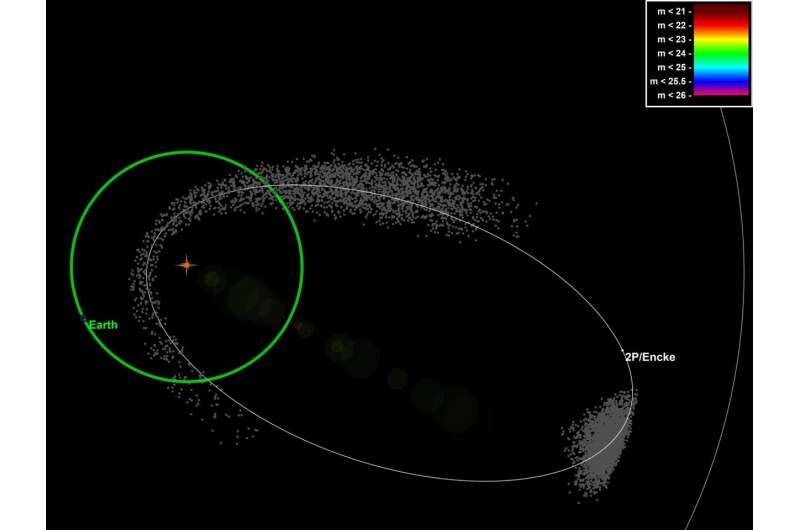A comprehensive study of the Taurid meteor stream confirms a central understanding of astronomer Dr. Bill Napier and the Comet Research Group, one which was incorporated into the YDI hypothesis from the start.
From Discover Magazine this week:
The longest-studied comets in our solar system have inspired ancient myths, religious fervor and modern scientific controversies. Now, the discovery of 88 asteroids and meteoroids orbitally aligned with one of them, Comet Encke, suggests that they all formed from the relatively recent breakup of an even bigger, icy comet. The findings are welcomed by those who believe Comet Encke and the other products of this astronomical event are responsible for many of Earth's most violent and consequential impacts over the last 20,000 years.....Long time readers can be forgiven for their lack of surprise. The Tusk and the peer-reviewed papers on the Younger Dryas Impact have long relied on the work of Clube and Napier. And now a wonderful and detailed new analysis from Ferrin and Orofino provides the best support yet for recurring disasters linked to one original object. These researchers reverse engineered the orbital history and outgassing status of dozens of major objects, all of which they have traced back to a single giant disintegrating comet during the Paleolithic. Much like this giant comet one on its way right now.
.....Such a dynamic, unpredictable and well-populated complex capable of frequently getting close to Earth stoked academic imaginations; astronomers began to rewind the clock and look for evidence of Earth's interactions with the Taurids in the archaeological record and beyond. Scientist Richard Firestone, now at the Lawrence Berkeley National Laboratory, in 2007 invoked the Taurid complex to explain global climate cooling at the start of a near-glacial period called the Younger Dryas and the sudden demise of the Clovis culture, a prehistoric people thought to be the ancestors of most indigenous peoples in the Americas. And last year, a team including Napier claimed to have found their own evidence of impact during the Younger Dryas: meltglass and scorched earth deposits that appeared to mark the demise of an early hunter-gatherer community in modern-day Syria.
Here's the abstract:
Taurid Complex Smoking Gun: Detection of Cometary ActivityAmong the surprises in the paper, the largest and last two major airbursts (to be widely recorded) are now traced to the Taurids. The orbital genetics and outgassing status indicate the Tunguska Event of 1908 and the February 15, 2013 Chelyabinsk explosion share parentage with the same object that wiped out the mammoth — and 250 other species — and initiated the Younger Dryas climate crash. Think about that. The two most horrifying impacts we know of are directly linked to a stream of debris which has interacted in a similar manner with our planet for 20,000 years. It's all of a piece.
Using the Secular Light Curve (SLC) formalism (Ferrín, 2010), we have catalogued 88 probable members of the Taurid Complex (TC). 51 of them have useful SLCs and 34 of these (67%) exhibit cometary activity. This high percentage of active asteroids gives support to the hypothesis of a catastrophe that took place during the Upper Paleolithic (Clube and Napier, 1984), when a large short-period comet, arriving in the inner Solar System from the Kuiper Belt, experienced, starting from 20 thousand years ago, a series of fragmentations that produced the present 2P/Encke comet, together with a large number of other members of the TC. The fragmentation of the progenitor body was facilitated by its heterogeneous structure (very similar to a rubble pile) and this also explains the current coexistence in the complex of fragments of different composition and origin. We have found that (2212) Hephaistos and 169P/NEAT are active and members of the TC with their own sub-group. Other components of the complex are groups of meteoroids, that often give rise to meteor showers when they enter the terrestrial atmosphere, and very probably also the two small asteroids that in 1908 and 2013 exploded in the terrestrial atmosphere over Tunguska and Chelyabinsk, respectively. What we see today of the TC are the remnants of a very varied and numerous complex of objects, characterized by an intense past of collisions with the Earth which may continue to represent a danger for our planet.
The paper also, without surprise, shatters Younger Dryas Impact antagonist Mark "The Bos" Boslough's weak attack here, as responded to by Napier, the Tusk and others here. Note the first link to Boslough's letter to PNAS. The other authors are David Morrison, Clark Chapman and Allan Harris. Each of these men have been paid their entire careers (thankfully now wound down) to downplay impacts threats and deny any historical incidents. Like Big Tobacco, the "impact establishment," unlike almost all field of science communication, has historically diminished the threat posed by their subject of study. The Tusk believes this anomaly can be attributed to intellectual fallout from the Cold War, where dangers which could distract from military fears were swept quickly under the rug — and kept there. (Until the Cold War ended, politics got involved, and a pivot was made to diminish any threat which could not in some way be attributed to Anthropogenic Warming).
Comment: That's particularly interesting because the originator of this theory, Victor Clube, wrote:
Cynics would say that we do not need the celestial threat to disguise Cold War intentions; rather we need the Cold War to disguise celestial intentions!
Bill Napier and Victor Clube deserve the Nobel Prize for unwinding the most important controlling factor in the earth and human history. We do not live in a "closed system," but rather a world characterized by long periods of quiescence, interrupted on discrete occasions by earth-shattering collisions from beyond. That is either the most important discovery in history — or it must be entirely refuted.
The Tusk will be waiting.
Read the paper here.




Comment: It good to see Bill Napier and Victor Clube getting the recognition they deserve. They've been voices in the wilderness for far too long.